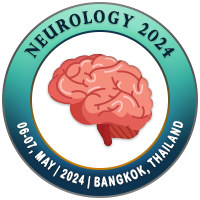
Raghavendra Bakki Sannegowda
Father Muller Medical College, IndiaTitle: Two interesting cases of pellagra encephalopathy with startle myoclonus and marked response to niacin therapy: A new dictum in neurology?
Abstract
A 56-year-old man, chronic
alcoholic, presented to us with progressive weakness in all the four limbs with
stiffness and gait disturbance since 1-year associated with cognitive
impairment. On examination he had mild confusion, spastic quadriparesis with brisk
reflexes, extensor plantars and cerebellar features. During the hospital stay
myoclonus was noticed in the patient, which was startle in nature. He did not
have dermatitis, ascites or any stigmata of liver failure. Magnetic resonance
imaging (MRI) of brain revealed bilateral subdural effusion, left focal
subarachnoid haemorrhage at perisylvian area and diffuse cortical atrophy.
He was treated with supportive
measures including thiamine with which his condition worsened. His serum niacin
was low. With a possibility of Alcoholic Pellagra Encephalopathy (APE) the
patient was treated with niacin. His clinical condition improved drastically
over next 1 week and startle myoclonus disappeared, favouring the diagnosis of
Alcoholic Pellagra Encephalopathy (APE) though multiple confounding factors
were present.
Another elderly lady suspected
malignancy with poor intake had loose stools. She was evaluated for the same.
In view of poor nutrition thiamine was initiated after which she developed
myoclonic jerks and startle response. Suspecting Pellagra Encephalopathy she
was initiated on Niacin Therapy through ryle’s tube. She showed dramatic
response to niacin therapy, her myoclonus and startle response disappeared.
Alcoholic Pellagra Encephalopathy
(APE) can present as a rapidly progressive Dementia Syndrome with myoclonic
movements and ataxia resembling CJD. The cases of APE are rare and there are
only few case reports. Isolated cases of Pellagra Encephalopathy been rarely
reported. Alcoholic Pellagra Encephalopathy Alcoholic Pellagra Encephalopathy
(APE) is an underestimated and under diagnosed clinical entity and one should
keep high index of clinical suspicion in any alcoholic patient who presents
with unexplained Progressive Encephalopathy, Ataxia and Myoclonus even other
features of pellagra are not found. Though it is a dictum that one should
supplement thiamine prior to the administration of dextrose in alcoholics, we
like to stress that one should supplement niacin in all alcoholic patients
before administration of thiamine to prevent the development or precipitation
of Alcoholic Pellagra Encephalopathy (APE) as these patients may worsen with
thiamine.
Biography
Dr. (Prof) Raghavendra Bakki
Sannegowda is currently affiliated to the Department of Neurology, Father
Muller Medical College, India, continuing research in the specialized
scientific area of Neurology. He has been awarded with multiple gold medals
during his undergraduate and postgraduate training days for pathology, Cardio
respiratory medicine (KMC). He has Authored innumerable articles in various
national and international journals related to Neurology, Neuroscience. He has
into his credit of being the Author of rare signs in neurology like “Hot cross”
and “reverse hot cross bun sign”, “panda Cub sign”, “wrist and jaw clonus”. For
his famous article “single dose does matter” he was invited as a speaker in
Frankfurt Germany and London UK.

